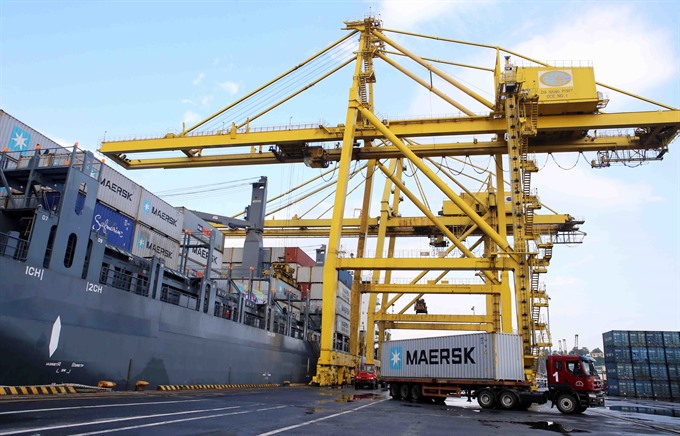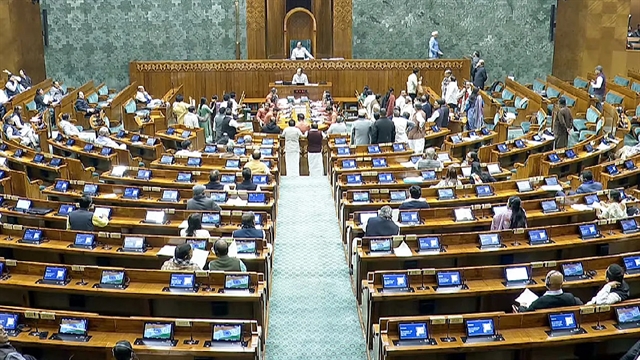 Economy
Economy

Small scale production, scattered investment, poor connections and logistics services set big challenges for key economic zones in the coastal central region, considered a major centre of logistics for the country.
 |
| Goods loaded at the Tien Sa Port in Da Nang City. — VNA/VNS Photo Tran Le Lam |
ĐÀ NẴNG — Small scale production, scattered investment, poor connections and logistics services set big challenges for key economic zones in the coastal central region, considered a major centre of logistics for the country.
Chairman of Việt Nam Logistics Association (VLA), Lê Huy Hiệp said this at a recent workshop on co-operation in developing logistics systems and centres in central Việt Nam’s key economic region.
“The region has 20 deep sea ports, but the system only handles 55.5 million tonnes of cargo – 13 per cent of the country’s sea ports per year. Meanwhile, the central region’s port system could host 300,000 TEUs (twenty-foot equivalent units), an equivalent of 2.8 per cent of total domestic market share,” Hiệp said.
“The regional port system only plays a role as a collection centre for cargo being sent to major ports in northern and southern Việt Nam. The region has only 422 businesses operating in logistics, with 8,000 labourers, and a revenue of VNĐ4 trillion (US$178 million),” he said.
Hiệp also said production capacity in industrial zones (IZs) across the region has not yet developed in supplying enough cargo for logistics businesses.
He said most ports lack high capacity piers for giant ship docking, while ageing facilities and services at ports could not meet the demands of investors.
Hiệp also complained that four airports, built at a distance of 200km or 300km from Đà Nẵng to Quảng Nam, Huế and Bình Định, only managed a small airfreight of 10.8 million passengers and around 1 million tonnes of cargo per year.
He said Đà Nẵng International Airport alone could play its role as a regional destination for international air cargo and flights.
Đà Nẵng hosts 6.7 million tourists, and 1 million tonnes of cargo per year.
Chairman of Đà Nẵng city’s People’s Committee, Huỳnh Đức Thơ, said the city plans to invest in a national logistics centre in Hòa Vang district, on an area of 30ha and with investment of $370 million.
Thơ said the centre will connect with the East-West Economic Corridor (EWEC) that links Việt Nam, Laos, Thailand and Myanmar, the Đà Nẵng-Quảng Ngãi Expressway as well as the north-south Việt Nam national highway and railway system.
He said the centre will be situated between two key ports – Tiên Sa and the anticipated new construction at Liên Chiểu.
Director of Việt Nam Institute of Economics, Trần Đình Thiên said logistics in Việt Nam is still new and the cost of logistics service is unusually high.
He said logistics counts for 25 per cent of the total cost that businesses and investors have to pay.
“The region has yet to develop as a transit hub for cargo from Laos, Cambodia, Thailand and the Central Highland region and the Greater-sub Mekong,” Thiên said.
He suggested the region needs a ‘maestro’ in arranging roles and the function of each port and airport.
He said Chân Mây port in Thừa Thiên-Huế could play a role as a cruise port rather than cargo port, while ports in Quy Nhơn, Dung Quất, Chu Lai and Đà Nẵng are set for specific demands of cargo, oil tankers or regular shipping routes.
Director of Chu Lai Open Economic Zone Authority (EZA) Đỗ Xuân Diện said exporters often pay an extra $30 or $50 to transport cargo by road from Quảng Nam to HCM City’s ports for export, while railway and expressways are yet to meet the demand of large cargo quantities.
Bùi Tất Thắng, director of the Institute for strategic development under the Ministry of Planning and Investment, said the region should be built up as a transit point for north-south cargo, with warehouses for exports and imports via EWEC.
He said the region should call on investment from the private sector in logistics in order to provide cheap and high quality services.
He said the region has not yet built linking roads to connect industrial parks, and economic zones to the national transport system (roads, railways, airports and seaports).
Nguyễn Xuân Thắng, from Fulbright University Việt Nam, said that a key logistics centre in Đà Nẵng could be a good choice as it helps connect Chân Mây port and Economic Zone in Huế, as well as Đà Nẵng-Quảng Ngãi Expressway in linking with Dung Quất and Chu Lai Economic zones in Quảng Ngãi and Quảng Nam.
He said Đà Nẵng should consider building a railway to transport cargo from Tiên Sa to the logistics centre.
He suggested each province could develop its own style of logistics centre for local demand, but it needs a Public-Private Partnership (PPP) investment model rather than from the State budget.
According to VLA, there are only 40 foreign shipping companies in Việt Nam, accounting for only 5 per cent of the country’s total number of shipping firms, but they transport up to nearly 90 per cent of Vietnamese import and exports, mostly to Europe, the US, the Middle East and Africa.
Quảng Nam has launched the first regular Chu Lai-Incheon, Korea sea route, and the Chu Lai–Trường Hải logistics and port service unit. — VNS

.jpg)


